12 Best Bourbons That Aren't Produced In Kentucky
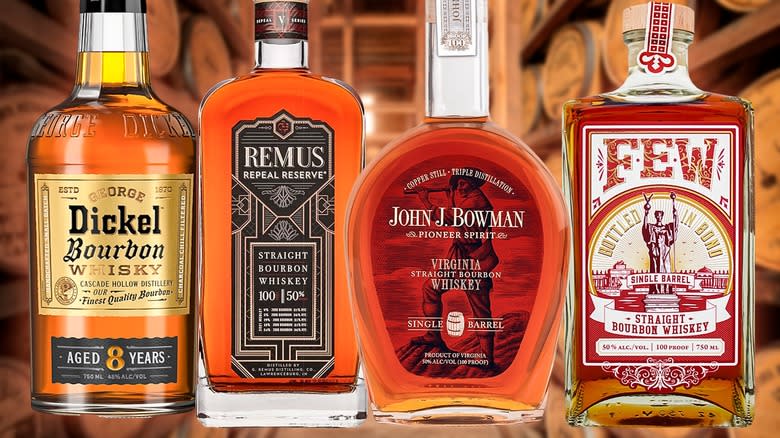
If bourbon mythology is to be believed, Elijah Craig opened a distillery in Kentucky, where he aged his corn whiskey in charred oak barrels, giving birth to the idea that it's only bourbon if it's distilled in Kentucky. Although this story is not verifiable, it solidified the idea that all great bourbon whiskey can only be created in the Bluegrass State.
But across the U.S., many distilleries are turning their hand to mythically fine bourbons of their own. Although some bourbon rules, such as a mash bill that is at least 51% corn, are set in stone, it's a misconception that bourbon must be distilled in Kentucky to be bourbon. Many people also don't realize that some of their favorite Kentucky bourbon started out as what's known as Midwest Grain Product (MGP) bourbon — a spirit that was distilled elsewhere but bottled or blended and aged in Kentucky. Bourbon cannot be labeled "Kentucky straight whiskey" unless it's distilled in that state, but this sourced bourbon refutes the notion that only the best bourbon comes strictly from Kentucky.
But out-of-state doesn't mean large distilleries churning out copycat bourbon. Distillers in states from coast to coast are utilizing local grains and small-batch offerings to make some delicious bourbon whiskey. If you're searching for a spirit with a different terroir than what's found in Kentucky, here's a list to get you started.
Read more: 13 Liquors Your Home Bar Should Have
FEW Spirits Straight Bourbon Whiskey — Illinois
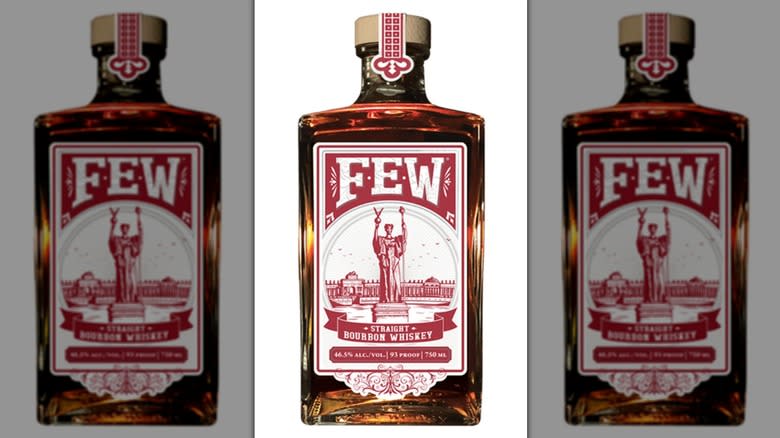
FEW Spirits, with its slogan, "Fortune favors the bold," is a relatively young distillery founded in Evanston, Illinois in 2011 by Paul Hletko. The name comes from the initials of a famous activist who founded the Woman's Christian Temperance Union (Frances Elizabeth Willard). This ironic gesture to a staunch supporter of Prohibition is present in the upstart character of its small-batch bourbon that is predominantly corn (70%, much more corn than is required to be considered bourbon), with Northern Rye (30%) and a dash of 2-Row Malt (10%) rounding out the mash bill.
It's a strong, spicy bourbon that tastes and smells of corn when the bottle is first opened. It's a very young bourbon, so many of the complex flavors in other offerings just aren't present here. Still, it has tasting notes of vanilla and caramel, with small hits of sour and bitter notes on the finish.
Because it is young and strong (like the distillery from which it comes), many bartenders favor this type of bourbon for cocktails. The bourbon flavor shines through even sweet mixers without disappearing, and the addition of bitters and juices smooths out the rough edges of this young spirit from Illinois.
Jimmy Red Straight Bourbon Whiskey — South Carolina
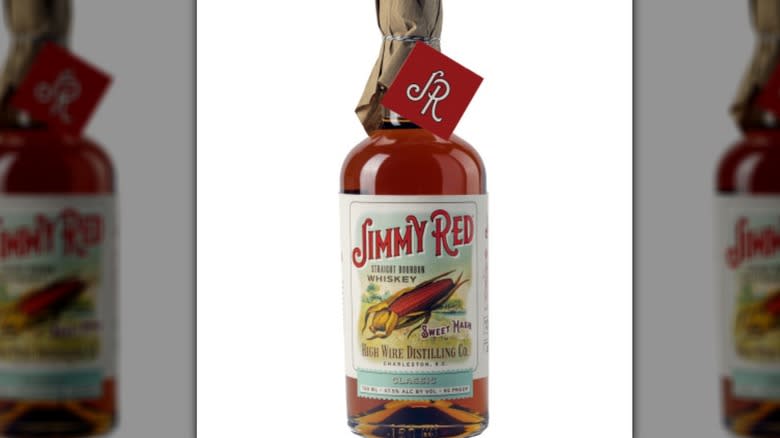
Jimmy Red Straight Bourbon Whiskey is the lovechild of revivalists invested in bringing heirloom grains back to the South. Although this jewel-toned corn was cultivated by indigenous people across the Midwest, the story of this bourbon starts in 1910, when Richard Humphries of Screven, Georgia brought JR corn to South Carolina. When industrial agricultural production forced JR corn nearly to extinction, Ted Chewning, a local farmer, saw what was happening and began cultivating Jimmy Red. Joined by Glenn Roberts of Anson Mills, chef Sean Brock, and Dr. David Shields of the University of South Carolina, Jimmy Red corn is now in the Slow Food Ark of Taste, a list of endangered foods that are considered part of the culinary heritage of a place. High Wire Distilling cultivates its JR corn for distillation.
So, this bourbon's 100% corn mash bill makes sense, as does the initial tasting notes of buttered popcorn and caramel. The nose is complex and shifts as the bourbon is exposed to air, with aromas of spice, coffee, lemon, and honey, plus oak from the barrels it is aged in. The lack of barley or rye in the mash bill means all of the flavors come from the heritage corn and the barrel in which it's aged. This means that the corn's beautiful complexity shines clearly through in the taste and the nose, with a long finish on the palate that continues to change from the first taste to the last.
George Dickel Bourbon Whiskey – Tennessee
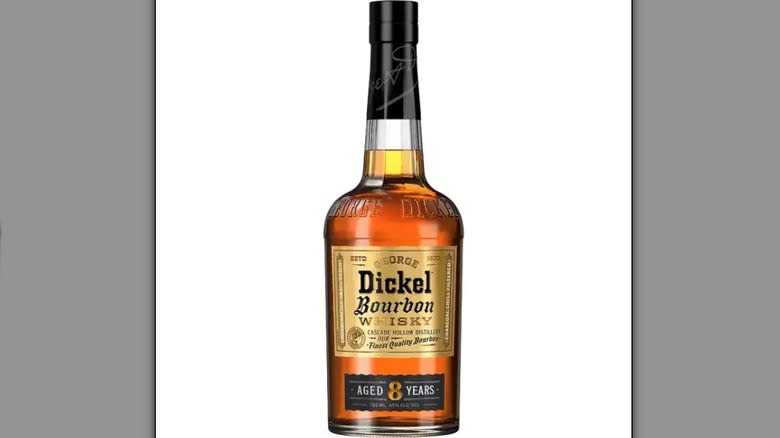
If you'd expect a Tennessee whiskey to come out of George Dickel instead of a bourbon, you would not be off the mark. Although it does not have the same national guidelines that govern bourbon, Tennessee law states that to be named Tennessee whiskey, it must go through a specific distillation process, steeping through 13 feet of charcoal (instead of distillation by gravity, as with bourbon). This process is the only thing that differentiates Dickel's bourbon and whiskey, but until now, George Dickel whiskeys were not generally labeled bourbon. George Dickel Bourbon Whiskey is the first to use the label.
With an 84% corn mash bill and an approximate age of 8-years-old, George Dickel bourbon leads with strong notes of vanilla before giving way to bright dried fruit and mild oak. Sweet flavors predominate as you sip, with hints of caramel, banana, and coconut coming to the forefront and washing away any tiny amount of spice and peppermint.
George Dickel offers its bourbon at a more affordable price point. There are no bold flavors or sharp zing of alcohol, making this an accessible offering for novice bourbon drinkers. It's not particularly complex, so if you're looking for something with a broader variety of tasting notes or a dynamic composition, this might not be for you.
John J. Bowman Single Barrel — Virginia
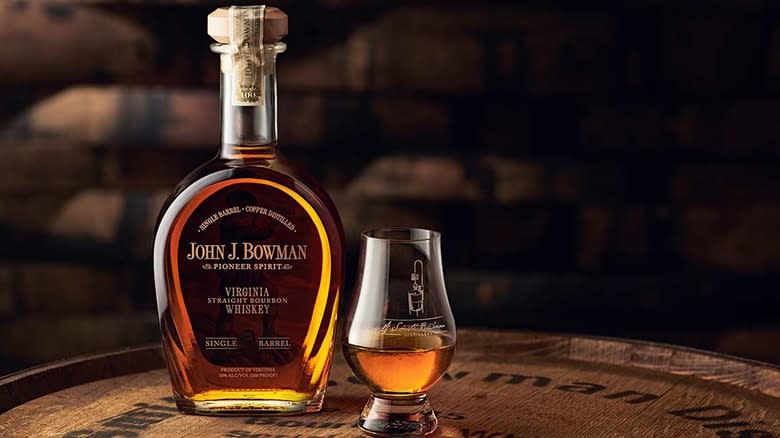
The origin story of John J. Bowman Single Barrel begins in Virginia when four brothers who were militia officers moved to Madison Family County, Kentucky in 1779. A great, great grandson purchased a farm in Northern Virginia and found himself with a surfeit of corn, wheat, and rye when Prohibition was repealed, so he opened the A. Smith Bowman Distillery. Today, the distillery is an hour's drive from its original location, offering its first bottles in 1991. John J. Bowman Single Barrel Bourbon takes its name from Colonel John Bowman, the first military commander and governor in Kentucky.
The mystique behind this bottle is the stuff of legends. (Unconfirmed) rumor has it that JJ Bowman is a sourced bourbon that is first distilled at Buffalo Trace distillery in Kentucky before A.Smith distills it twice again in a copper still and ages it on-site. The distillery is mum on everything from its mash bill to the age of its bourbon.
If this is true, then JJ Bowman shares the rarified air occupied by the likes of E.H. Taylor and Eagle Rare, two exceptional Kentucky bourbons from the Sazerac company (the owners of Buffalo Trace). It's a classic bourbon with notes of vanilla, caramel, and spice. These carry through to the finish, which is long and pleasant. This is not an overly complicated bourbon, making it a great introduction to bourbon in general.
Balcones Texas Blue Corn Bourbon — Texas
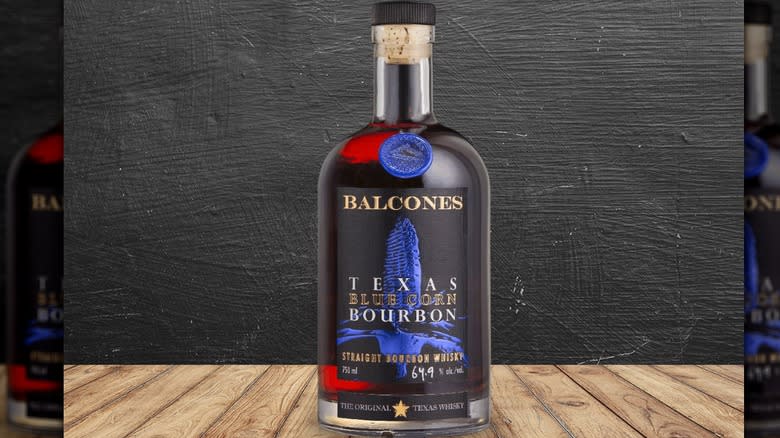
Balcones Texas Blue Corn Bourbon is as big and bold as the state from which it comes. Named for the Balcones Escarpment — a geographical feature that determines where the South ends and the West begins — this distillery combines the natural landscape with the cultural one, producing spirits (bourbon is just one) that embrace the independent spirit that is cultivated in the existence between the Texas Coastal Plain and the West Texas Hill country. The distillery uses a 100% blue corn mash bill and ages each bottle for at least 38 months.
This bourbon is a higher-proof spirit (127, 63.5% ABV when bottled) that is distilled using a pot still. Because it's aged in uncharred oak casks, there is some debate as to whether this spirit belongs on a bourbon list. That's splitting hairs. This bourbon has the characteristic vanilla and toffee bourbon notes and a rich mouthfeel. The high ABV doesn't translate into a hot sip — in fact, from beginning to end the taste and aroma are sweet and light.
In the end, Balcones Texas Blue Corn Bourbon finishes with richer flavors of cedar and pepper, with hints of oak. Subtle notes of citrus and caramel popcorn linger, too. The complexity of this bourbon is a tribute to how much flavor a plain oak cask can impart (and what a difference the variety of corn makes). Add a few drops of water to get the full effect.
Redwood Empire Pipe Dream Bourbon Whiskey — California
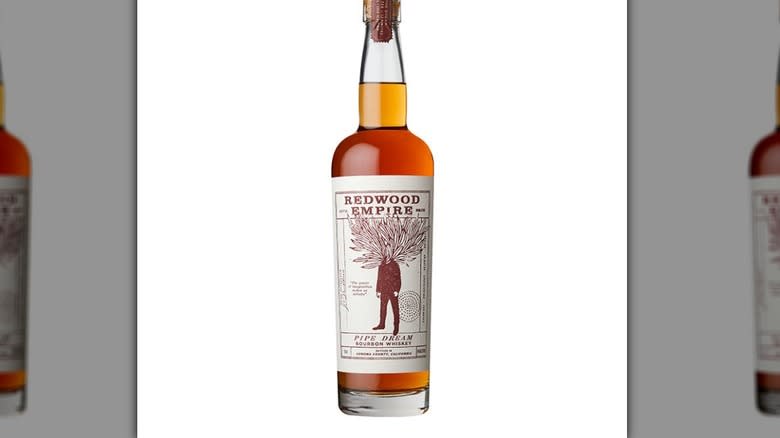
Some bourbon drinkers are snooty about blended whiskey, but Redwood Empire is here to change that. The area referred to as the Redwood Empire reaches from San Francisco to the Oregon border. Here, giants of the forest tower, with protected groves of Muir Woods and Humboldt Redwoods standing sentry. Redwood Empire is as committed to protecting these primeval trees as they are to making delicious bourbon — for every bottle sold, this distillery plants a tree, to the tune of just over 1,136,000 trees planted so far.
Sourcing from distilleries in California, Indiana, Kentucky, and Tennessee, Redwood Empire blends bourbons between four and 12 years old to produce a bottle with notes of maple candy, dried fruit, and sugar cookies. It is a delicious example of the traditional bourbon flavor profile and mouthfeel, with buttery, smooth notes and body. The finish is clean, with hints of black pepper and some fresh fruit. It's the perfect introduction to bourbons for someone looking for a way into the sometimes overwhelming flavor profiles of bourbons with stronger ABV and more complex notes.
Remus Repeal Reserve Straight Bourbon Whiskey – Indiana

Remus Repeal Reserve is one of the fine bourbons coming out of this Midwestern distiller. This annual tribute to the repeal of Prohibition is a limited-release bourbon whiskey that's different every year. It's named for "King of the Bootleggers" during Prohibition (George Remus). Produced in Lawrenceburg, Indiana, a city nicknamed Whiskey City since the mid-1800s, by Ross & Squibb Distillery, Remus Repeal pays tribute to one ingredient that makes it special: water. The city sits atop the Great Miami Aquifer. Distilling with naturally limestone-filtered water reduces the sulfur and iron that can produce off-tastes in whiskey.
While every year in this series is slightly different, most bottles share some characteristic tastes and aromas. The initial aroma of this bourbon is heavily wooded, with oak and cedar coming in first, followed by the sweetness of honey and brown sugar. Tasting notes are of fruit, with things like citrus, cherry, and even dates at the first sip. Throughout the glass, rich flavors of spice tempered by vanilla keep each sip smooth and mellow. At its finish, brown sugar and buttery rich toffee flavors linger, as do deeper notes of tobacco, oak, and even leather.
One of the best ways to bring out a bourbon's flavor is to add a few drops of water, and this is a good idea here. Each version of bourbon in this annual series sells out quickly, so keep an eye out and act fast when you see it.
Widow Jane 10 Year Bourbon Whiskey — New York
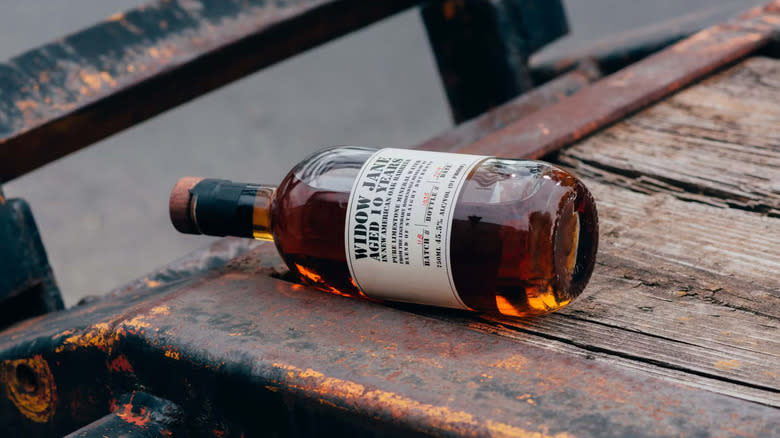
Widow Jane's 10-Year Bourbon Whiskey is routinely showered with accolades. Perhaps one reason is that it starts in the birthplace of bourbon before being aged in barrels in Red Hook, New York. Although its mash bill and originating distillery remain undisclosed, what is known is that this bourbon is consistently delicious, with a smooth, complex flavor profile that's developed over a minimum of six years of aging (and in this case, a full decade).
Widow Jane is the oldest of whiskies at the distillery, made in small batches and proofed with water from the Rosedale Mines (a.k.a. the Widow Jane Mines) of New York. The result is a beautifully smooth bourbon with tasting notes of vanilla, cinnamon, cherries, and spice. Because at 91-proof it's considered a lower-proof bourbon, there is no sharp ethanol smell. The nose is of oak, corn, vanilla, and the charred barrels in which it's aged.
Pepper and oak are present on the finish, which flares hot and then subsides. It's worth considering the high price point of this single-barrel bourbon. It has a solid traditional bourbon flavor, but if you don't want to come out of pocket to the tune of $75 per bottle, there are other similar bourbons to be had for less.
Woodinville Straight Bourbon Whiskey – Washington
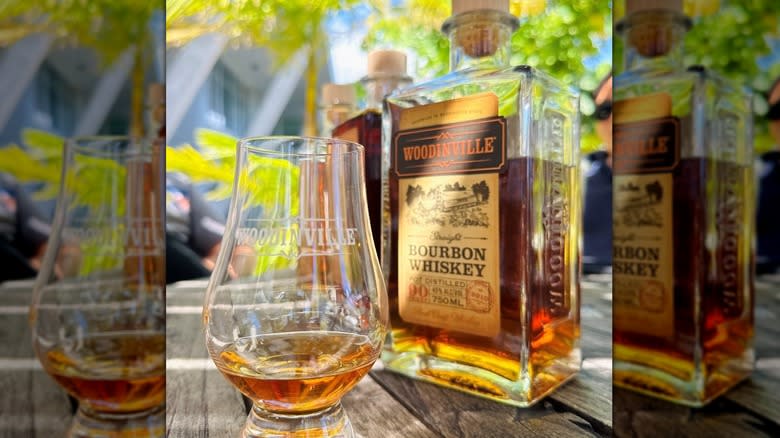
When you're a start-up distiller looking to bring back the art of small-batch bourbons produced with locally grown grain and barreled in barrels coopered nearby, you want to make sure the product honors the ingredients and is done properly. That's why Woodinville Whiskey founders Orlin Sorensen and Brett Carlile worked with David Pickerell, the master distiller at Maker's Mark for 14 years, when they started their journey toward this bourbon.
The corn, rye, and barley for this bourbon are locally grown in Woodinville before it's turned into white lightning and sent over the Cascade mountains to age for 18 months. But it's not just the bourbon that's the story. This distillery pays attention to the detail of the barrel. The oak for each barrel is seasoned for 18 months, and exposed to the elements to mellow the tannins that are present. The wood is then coopered and slowly toasted, charring the barrel slowly.
The result of this attention to detail from grain to barrel is a bourbon with exceptionally creamy flavors of vanilla, caramel, and toasted oak. It finishes more deeply, with earthy flavors of leather, brown sugar, and more of that toasty oak. The lower proof means the taste is not too complex, but it's a remarkably enjoyable, award-winning spirit that is easy to sip.
Smooth Ambler Contradiction Bourbon— West Virginia
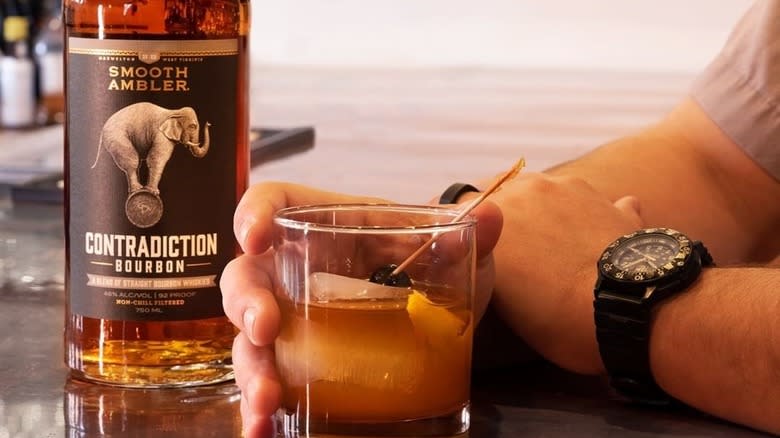
Smooth Ambler's Contradiction Bourbon is a lot like the state it comes from: deeply down-home but influenced also by states outside its borders. In the case of Smooth Ambler Contradiction Bourbon, the distillery blends whiskey from Indiana and Tennessee with its own wheated bourbon distilled in West Virginia. This bourbon is the perfect metaphor for the can-do spirit that lives in Appalachia. It's an upstart in a region that is known more for moonshine, and it's winning awards (including a gold medal at the World Whiskey Awards).
The balance of the blend is 27% of a Smooth Ambler 2-year-old wheated bourbon and 73% of a 9-year-old high-rye MGP bourbon. These are blended and then barreled in the original barrel for another three months. This four-grain bourbon smoothes out the rough edges of the wheated bourbon, the taste of which pops forward on the first sip, followed by notes from the older bourbon. The characteristics of the wheated bourbon then become more forward, resulting in spicy heat that can be intimidating.
This bourbon finishes dry, with lots of wood. Although there are sweet notes of green apple and vanilla, this bourbon is not a traditional bourbon in either the nose, the taste, or the finish. If you are not an experienced bourbon drinker, this is not the one to start with. For those who like something a little different, an ice cube opens up more complexity and can make it a more enjoyable experience.
Kings County Peated Bourbon — New York
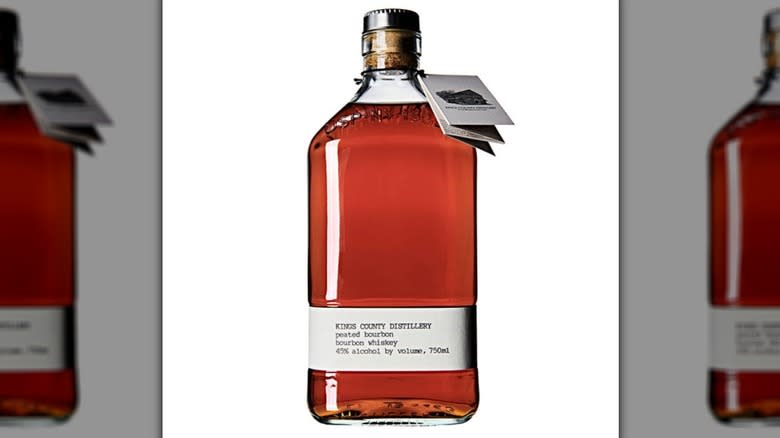
Scotch drinkers who appreciate the smoky taste of peat will love it in this small-batch, young bourbon. Peated whiskey gets its distinct flavor by burning the peat under the whiskey vats, and this bourbon from Kings County Distillery follows this method. Not only does this bourbon meet all of the requirements of bourbon whiskey in its mash bill and aging, but this distillery also exposes it to peat smoke and uses malt that is grown and kilned in Scotland. These two traditions blend seamlessly to produce a spirit that satisfies two sides of the whiskey coin: those who prefer Scotch and those who drink nothing other than bourbon.
The burning peat and peat-smoked malt shine through with a distinct note of campfire smoke complementing the sharp bourbon flavor. Smoke results in less sweetness than a regular bourbon, and the nose and taste are reminiscent of toasted marshmallows and sea salt. It has a full body with hints of smoke throughout but also complex changes as you sip, encompassing everything from traditional vanilla notes to leather and even rubber.
That may not sound appetizing to the bourbon drinker, but this gold medal-winning tipple is worth a try. Grab your favorite Scotch drinker and have a side-by-side comparison of the two types of whiskey to get a better idea of how one influences the other.
Dry Fly Straight Bourbon 101 Whiskey – Washington
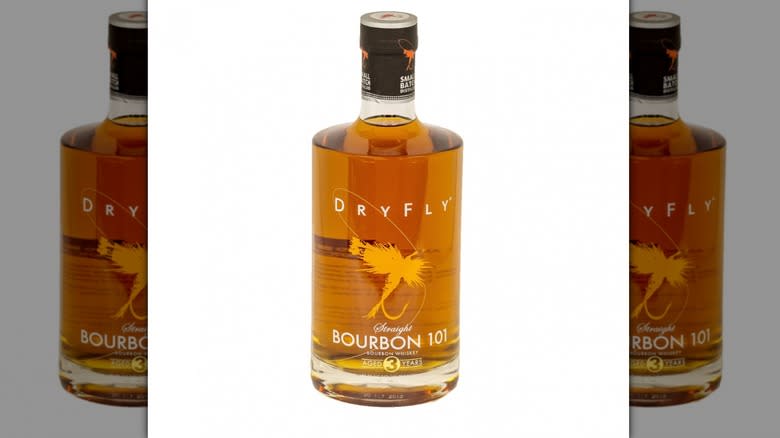
We end our list with another great bourbon from Washington State. Dry Fly Distilling uses a straightforward mash bill of 55% corn and 45% triticale in its bourbon, a hybrid grain that marries wheat and rye. Triticale was first produced in the lab in the late 19th century and has been used in just a handful of whiskies in the U.S. The result of this non-traditional grain combination is a light-colored spirit with a big punch of flavor.
Dry Fly Straight Bourbon 101 Whiskey weighs in at 101 proof, a high-proof tipple that was the first of its kind produced in Washington. On the nose, big orange aromas and sweetness from the wheat are present, as are floral notes. The orange makes an appearance on the first taste, too, with vanilla present. There is bread in the finish, a testament again to the wheat.
Wheat seems to be the big story here, beating up some of the other more subtle flavors. This is not necessarily a bad thing. The fullness of citrus rounded out by bready flavors and aromas makes for an unusual sip that's a pleasant departure from the traditional.
Read the original article on Tasting Table.
